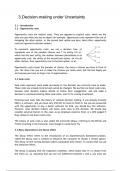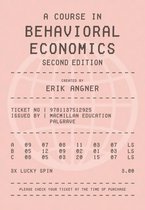3.Decision-making under Uncertainty
3.1 - Introduction
3.2 - Opportunity costs
Opportunity costs are implicit costs. They are opposed to explicit costs, which are the
ones you pay when you buy an object for exemple. Opportunity costs represent the cost of
foregoing the other option, or the second best option you have. Most often, opportunity
costs are ignored by decision makers.
To represent opportunity costs, we use a decision tree. a1
represents one of the possible choices and 7 its utility. For a1,
which has the best utility, the number between parentheses is its
opportunity cost: the utility of the second best option, a4. For all
other choices, their opportunity cost is the best option, so a1.
Opportunity costs reveal the paradox of choice: the more n choices you have in front of
you, the more free you are to make the choices you really want, but the less happy you
are because you have to forgo a lot of opportunities.
3.3 Sunk costs
Sunk costs represent costs made previously to the decision you currently have to make.
These costs are already incurred and cannot be changed. We say that we honor sunk costs,
because most decision makers decide to follow their engagement, and will make a
decision to continue honoring these sunk costs, even if it's a losing investment.
Honoring sunk costs fails the theory of rational decision making. If you already invested
€9M in a software, and you have only €1M left to invest to finish it, but you are presented
with the opportunity to buy a better software for €1M, you should buy this software.
However, most decision makers will honor sunk costs in this decision. We should also
consider external factors in this case, as an employee could be fired, or a CEO judged if
they choose to not honor sunk costs.
The fallacy of sunk costs is also called the Concorde fallacy, referring to the British and
French investing in the Concorde, even though it would never fly.
3.4 Menu dependence and decoy effect
The decoy effect refers to the introduction of an asymmetrically dominated product,
called the decoy, that is created to influence the consumer to choose a certain option.
This decoy is here to help decision makers rationalize their choice. It creates what we call
the attraction effect.
The decoy is playing with the expansion condition, which states that if x is chosen from
the menu {x, y}, assuming that you are not indifferent between x and y, you must not






